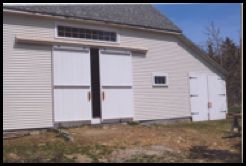Click on an image below to open a portfolio

Acadian Farmhouse
This farmhouse with French roots is located on the Blue Hill peninsula, the western edge of Acadia when the French governed the coast from the Penobscot River to Cape Breton. Like the English, the French brought their native building traditions with them when they established settlements in North America. My interest in French colonial architecture began when I was an undergraduate in the 1980s and visited New Orleans and the lower Mississippi valley for the first time. When I was older and studied the development of this tradition as it spread from Quebec down the Mississippi to Louisiana and up from the Caribbean, I was impressed by the adaptability of the basic French form to the extremes of weather and climate from cold, snowy north to wet, humid tropics. The protection provided by the steep-pitched hipped roof and the openness and connection to the outdoors offered by the tall casement windows and French doors both appealed to me. So when Heather Lyon contacted me and said she was moving back to Blue Hill from France with Jean-Charles Brunelliere, her French husband, I was excited by the opportunity to design and build them a house.
I think the plan we ended up with for a small French farmhouse wouldn't be out of place in the countryside of Normandy, except for the eastern white cedar shingles. I call it an Acadian farmhouse because although its roots are French, its materials are mostly from Maine and the design has been adapted to Maine's harsher climate and weather. In addition to the native shingles, it has a foundation of Sullivan granite; a frame of pine and oak cut and milled in Maine, with additional components of birch, spruce and cherry cut and milled at the site; spruce and pine boards (again some cut and milled at the site); and an earthen floor that is made from Brooksville clay. Three-foot overhangs protect the building from all but the most driving rainstorms, and the super-insulated walls and ceiling (R-35 and R-60, respectively) keep the inside warm during the coldest winter nights.

Sunrise Cottage
This 1000-sf house has two bedrooms and one bath. The open floor plan downstairs and the six sets of double casement windows that line the south side give it an open sunny feel. French doors lead from the kitchen to a small terrace overlooking Blue Hill. The design, drawn from patterns that are common throughout the eastern half of the United States, evokes a very small two-room farmhouse with a wrap-around addition. The frame was cut from eastern white pine and northern red oak. The walls are all plastered with a lime/clay/straw mix that allows us to do a single coat with no cracking. The super-insulated walls and ceiling make it very easy to heat with just a little wood or propane.

Big House, Little House…
…Back House, Barn. This restoration and renovation of a classic Maine farmstead in Franklin took the better part of a year. We did major structural repairs to the timber-framed house (circa 1860) and barn (circa 1900), built new doors and windows for the barn, replaced windows and rebuilt the eaves and rake overhangs for the house, and finally put new clapboards and shingles on all the connected buildings of the farmstead, which measured 150 feet from one end to the other.

East Blue Hill House
We began our current project by taking down a conventional stick-built house on the site and carefully salvaging the framing lumber, sheathing boards, and rigid insulation. We used the lumber and boards to build the trusses that enclose the timber frame, while we used the rigid insulation under the mass floor and inside the fieldstone stem wall. In our house designs, our first goal is to build for beauty and comfort, but a close second is to use the most ecologically benign materials. With that in mind, we've eliminated concrete (responsible for 7-10% of greenhouse gases), plywood (an industrial forest product of questionable durability), and sheetrock (a lifeless, standardized product that encourages lifeless, standardized houses).
I'm a timber framer and woodworker by trade, but my favorite part of this house is the dry stack foundation wall. Local mason Ken Hoffman fitted the stones together by hand over the course of a hot summer. We capped it with a tamarack sill. The combination raises the house onto a mound two-and-a-half feet above the surrounding land. This not only protects the building's wooden parts from moisture, but the large mass floor inside the building provides a huge heat sink that will keep the building warm in winter and cool in summer. I've learned from previous buildings that this mass floor system is so effective that even with a downstairs wood stove running full bore in winter the upstairs rooms and cathedral ceiling will actually be cooler, since so much of the fire's heat is being stored in the floor. Once the fire goes out at night, the floor slowly releases the heat so that overnight the upstairs temperature only drops by a couple of degrees, regardless of the outside temperature.


